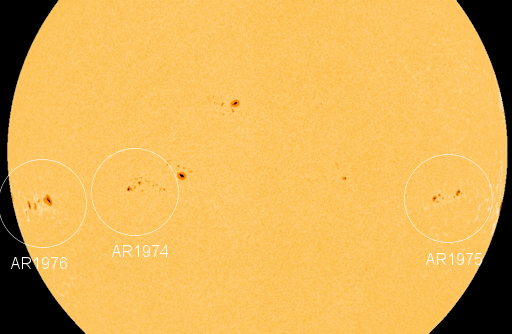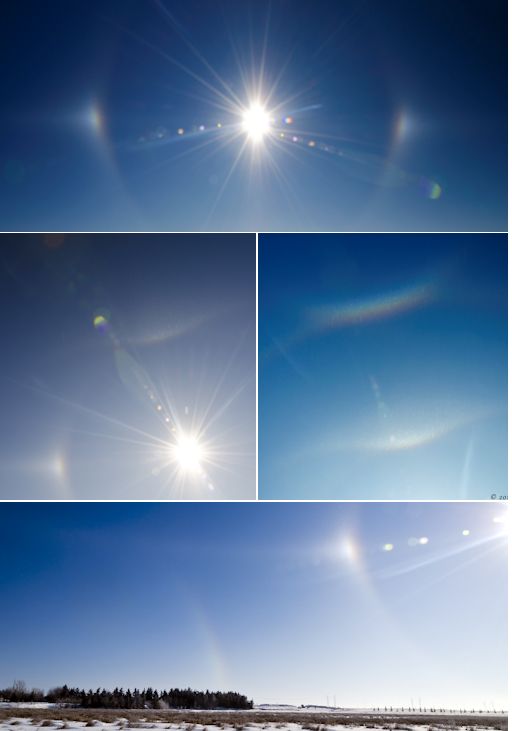Listen to radar echoes from satellites and meteors, live on listener-supported Space Weather Radio. | | | EDGE OF SPACE VALENTINE'S CARD: It's heavenly, it's romantic, and most of all it's experimental. We're talking about an Edge of Space Valentine's Card! If you would like to have a picture of your choice photographed 120,000 feet above Earth's surface, submit your graphic and a $49.95 flight fee today. The student balloonists of Earth to Sky Calculus will fly it to the stratosphere on Feb. 11th. If all goes as planned, you'll have the photo back in time for Valentine's Day. Money back guarantee if it doesn't work Email Dr. Tony Phillips for details. JUPITER AND THE MOON: When the sun goes down tonight, step outside and look up. Jupiter and the gibbous Moon are only 5o apart--tight enough to fit inside the bowl of the Big Dipper. The bright conjunction is easy to see even from light-polluted cities. Take a look! EMERGING SUNSPOTS: Over the weekend, active sunspots AR1967 and AR1968 rotated off the solar disk. However, the chance of flares has not decreased very much. Three new active regions have popped up to take their place: 
The circled sunspots, AR1974 - AR1976, have 'beta-gamma' magnetic fields that harbor energy for medium-sized eruptions. And they are growing. NOAA forecasters estimate a 40% chance of M-class flares and a 5% chance of X-flares on Feb. 10th. Solar flare alerts: text, voice Realtime Space Weather Photo Gallery 'MAGICAL' ICE HALOS OVER CALGARY: Yesterday, sky watchers around Calgary, Canada, witnessed a magnificent display of ice halos around the sun. "It was magical--the best I've ever seen," reports photographer Dee Cresswell, who needed four exposures to capture all of the glowing arcs: 
"The temperature was around -22 C, with a windchill in the mid minus thirties," she continues. "You could actually see the ice crystals shimmering in the air. There was a 22° halo, a 46° halo, infralateral arcs, tangent arcs, circumzenithal arc, a parhelic circle and more." Atmospheric optics expert Les Cowley created a diagram labeling the halos: click here. He says they were created by a special kind of ice crystal called "diamond dust." "Diamond dust--that is, low level ice crystals shaped as hexagonal plates and columns--make the very best halos because the crystals are large and of good optical quality," explains Cowley. "Plates made the bright sundogs and the circumzenithal arc while column crystals generated the upper tangent arc and the rarer supralateral and infralateral arcs. More peculiarly oriented columns gave the not often seen Parry arc. A few randomly tilted crystals produced the faint 22-degree halo and only a hint of the 46-degree circle. Supralateral arcs and the rarer 46° halo can be hard to tell apart." "Even though wintry diamond dust is the king of halos,ordinary ice crystals in high clouds can give fine displays all year long. No matter where you live, or what time of year, keep an eye out for halos." Realtime Space Weather Photo Gallery
Realtime Aurora Photo Gallery
Realtime Comet Photo Gallery
Every night, a network of NASA all-sky cameras scans the skies above the United States for meteoritic fireballs. Automated software maintained by NASA's Meteoroid Environment Office calculates their orbits, velocity, penetration depth in Earth's atmosphere and many other characteristics. Daily results are presented here on Spaceweather.com. On Feb. 8, 2014, the network reported 4 fireballs.
(4 sporadics) 
In this diagram of the inner solar system, all of the fireball orbits intersect at a single point--Earth. The orbits are color-coded by velocity, from slow (red) to fast (blue). [Larger image] [movies] On Feb. 5, 2014, the network reported 2 fireballs.
(2 sporadics) 
In this diagram of the inner solar system, all of the fireball orbits intersect at a single point--Earth. The orbits are color-coded by velocity, from slow (red) to fast (blue). [Larger image] [movies]
Potentially Hazardous Asteroids ( PHAs) are space rocks larger than approximately 100m that can come closer to Earth than 0.05 AU. None of the known PHAs is on a collision course with our planet, although astronomers are finding new ones all the time. On February 10, 2014 there were potentially hazardous asteroids. Notes: LD means "Lunar Distance." 1 LD = 384,401 km, the distance between Earth and the Moon. 1 LD also equals 0.00256 AU. MAG is the visual magnitude of the asteroid on the date of closest approach. | | The official U.S. government space weather bureau | | | The first place to look for information about sundogs, pillars, rainbows and related phenomena. | | | Researchers call it a "Hubble for the sun." SDO is the most advanced solar observatory ever. | | | 3D views of the sun from NASA's Solar and Terrestrial Relations Observatory | | | Realtime and archival images of the Sun from SOHO. | | | from the NOAA Space Environment Center | | | the underlying science of space weather | | 
